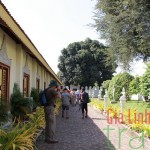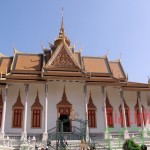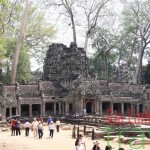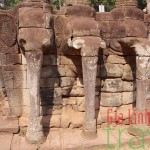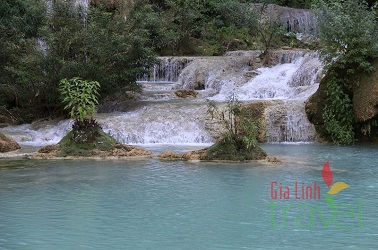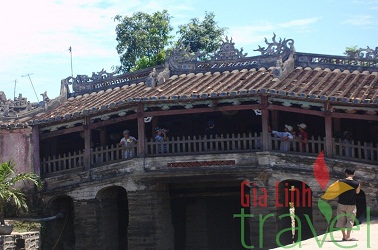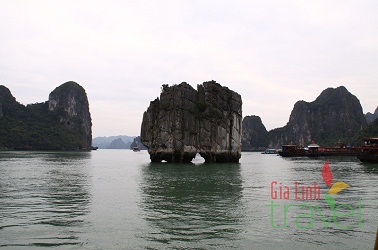Cambodia 7 day tour
An impressive and attractive program
Phnom Penh /Siem Reap
Considered as the Pearl of Cambodia, Phnom Penh attracts everyone with its charm, houses much sensational colonial architecture and iconic landmarks.
Once in Siem Reap, the famous temples of Angkor, Angkor Thom, Ta Prohm, Banteay Srei, Banteay Samre, and Pre Rup – all these Khmer-style temples, built between the 10 – 13th centuries, are impressive and certainly not to be missed.
PROGRAMME IN DETAILS FOR CAMBODIA 7 DAY TOUR
Destination: Phnom Penh /Siem Reap
Description: Considered as the Pearl of Cambodia, Phnom Penh attracts everyone with its charm, houses much sensational colonial architecture and iconic landmarks. Once in Siem Reap, the famous temples of Angkor, Angkor Thom, Ta Prohm, Banteay Srei, Banteay Samre, and Pre Rup – all these Khmer-style temples, built between the 10 – 13th centuries, are impressive and certainly not to be missed.
B=Breakfast, L=Lunch, D=Dinner, G=Guide
Day 1: Phnom Penh Arrival (L, D, G)
Transfer from Phnom Penh International Airport to the hotel.
Lunch at local restaurant.
Phnom Penh city tour: Visit the Victory Monument, and the National Museum, also called Musee des Beaux-Arts. A French archaeologist and painter, Georges Groslier, designed it in Khmer style in 1917. The museum contains a collection of Khmer art – notably sculptures – throughout the ages. Visit the Royal Palace, built by King Norodom in 1866 on the site of the old town, and the Silver Pagoda. Located within the Royal Palace, the Silver Pagoda is so named because of its floor, which is made up of 5000 silver tiles. The treasures found inside include a solid gold Buddha encrusted and weighing 90kilograms and a small 17th century emerald and baccarat crystal Buddha. End your afternoon with the visit of the Wat Phnom Temple, Phnom Penh’s namesake, from where you can enjoy views over the tree-lined avenues of Phnom Penh during sunset. Dinner at local restaurant and accommodation at hotel.
Day 2: Phnom Penh/Siem Reap (B, L, D, G)
Breakfast at hotel
Transfer to Phnom Penh International Airport and departure by Siem Reap Airways International or similar to Siem Reap. Arrive at Siem Reap International Airport and transfer to the hotel (rooms may not be ready until the afternoon).
Visit the Roluos Group. The monuments of Roluos, which served as the capital of Indravarman I (reigned 877-89), are among the earliest large, permanent temples built by the Khmers and mark the beginning of Khmer classical art. Preah Ko erected by Indravarman I in the late 9th century dedicated by the King to his ancestors in 880. Bakong the largest and most interesting of the Roluos group temples, with his active Buddhist monastery just to the north of the east entrance. Lolei built on an islet in the center of a large reservoir (now rice fields) by Yasovarman I, the founder to the first city at Angkor.
Lunch at local restaurant.
In the afternoon, continue your temple tour to the unique interior brick sculptures of Prasat Kravan, Srah Srang (“The Royal Baths” was once used for ritual bathing), Banteay Kdei (surrounded by 4 concentric walls), Eastern Mebon, (guarded at its corner by stone figures of harnessed elephants, some of which are still in a reasonable state of preservation) and the mountain-temple of Pre Rup until sunset. Dinner at local restaurant and accommodation at hotel.
Day 3: Siem Reap (B, L, D, G)
Breakfast at hotel.
In the morning, drive to the typical Khmer countryside and visit Banteay Srei temple (10th c), regarded as the jewel in the crown of Classical Khmer Art. Continue to visit Banteay Samre, one of the most complete complexes at Angkor due to restoration using the method of “anastylosis”. The name Samre refers to an ethnic group of mountain people, who inhabited the region at the base of Phnom Kulen and were probably related to the Khmers. No inscriptions have been found for this temple, but the style of most of the architecture is of the classic art of the middle period similar to Angkor Wat. The proportions of Banteay Samre are splendid. A unique feature is an interior moat with laterite paving, which when filled with water must have given an ethereal atmosphere to the temple.
Lunch at restaurant.
In the afternoon, you will continue your temple visits to Preah Khan. Built by the King Jayavarman VII, Preah Khan is, like Ta Prohm, a place of towered enclosures and shoulder hugging corridors. Unlike Ta Prohm, however, the temple of Prea Khan is in a reasonable state of preservation and ongoing restoration efforts should maintain and even improve this situation. Continue to Neak Pean, a fountain built in the middle of a pool (representing the paradisiacal Himalayan mountain-lake), and Ta Som. Dinner at local restaurant and accommodation at hotel.
Day 4: Siem Reap (B, L, D, G)
Breakfast at hotel.
Morning, visit the most famous of all the temples on the plain of Angkor: Angkor Wat. The temple complex covers 81 hectares and is comparable in size to the Imperial Palace in Beijing. Its distinctive five towers are emblazoned on the Cambodian flag and the 12th century masterpiece is considered by art historians to be the prime example of classical Khmer art and architecture. Angkor Wat’s five towers symbolize Meru’s five peaks – the enclosing wall represents the mountains at the edge of the world and the surrounding moat, the ocean beyond.
Lunch at local restaurant.
Visit the South Gate (with its huge statues depicting the churning of the ocean of milk), the ancient capital of Angkor Thom (12th century), Bayon Temple (unique for its 54 towers decorated with over 200 smiling faces of Avolokitesvara), the Royal Enclosure, Phimeanakas, the Elephants Terrace and the Terrace of the Leper King. Sunset at Angkor Wat. Dinner at local restaurant and accommodation at hotel.
Day 5: Siem Reap (B, L, D, G)
Breakfast at hotel.
Morning, drive to the remote Beng Mealea temple through the typical Khmer countryside (60Kms from Siem Reap). There is a lot to see in the approximately 2 hours drive as it takes you through many lively villages and along kilometers of rice paddies. Explore the long abandoned temple (11th C), strangled by the jungle.
Lunch box will be provided at the site.
A further 1 hr drive brings you to Koh Ker, situated in the northeast of Siem Reap. Discover the long abandoned temples in the forests of northern Cambodia. Also known as Chok Gargyar, it served as the capital of Jayavarman IV (reigned 928-42). His son and successor Harshavarman I moved the capital back to Angkor in 944. There are a remarkable number of religious buildings in the Koh Ker region, considering the short space of time that it was the capital of the empire. There are more than 30 major structures and experts believe there may have been as many as 100 minor sacred buildings in the region. It was also a prolific period for gigantic sculpture and several of the most impressive pieces in the National Museum in Phnom Penh come from Koh Ker, including a huge garuda (half-man, half-bird creature). Return to Siem Reap. Dinner at local restaurant and accommodation at hotel.
Day 6: Siem Reap (B, L, D, G)
Breakfast at hotel.
Morning, visit the floating village of Chong Khneas, located 10 kilometers south of Siem Reap. Visit the village and take an excursion in a traditional wooden boat on the Tonle Sap Lake, the “Great Lake” of Cambodia, one of the wonders of Asia.
Lunch at local restaurant.
Afternoon, continue the temples tour: Takeo, Thommanon, Chau Say Tevoda and Ta Prohm, one of the most beautiful temples in the area, as it has been relatively untouched since it was discovered and retains much of its mystery. Its appeal lies in the fact that, unlike the other monuments of Angkor, it was abandoned and swallowed by the jungle, looking very much the ways most of the Angkor temples appeared when European explorers first stumbled upon them. Dinner at local restaurant and accommodation at hotel.
Day 7: Siem Reap Departure (B, L, G)
Breakfast at hotel.
In the morning, drive from Siem Reap to the district of Puok. Visit the Silk Farm of Puok. Learn the different stages of the complex process of producing handmade silk. Before returning to Siem Reap, visit the nearby Western Baray and the temple of Western Mebon.
Lunch at restaurant.
Afternoon at leisure before transfer to Siem Reap International Airport for departure to the next destination. Visit to the Dance school of Aspeca where you can watch young children learn the ancient traditional Khmer dances. Visit Wat Inkosei built on the site of an ancient temple, which still remains. Continue to Wat Bo pagoda to view its well-preserved paintings. You will also observe monks making the various moldings, which adorn the pagodas. Visit a workshop where traditional shadow play puppets are made.
Price in US$ per person:
Our price includes:
Private tours with English speaking guide for the entire trip except leisure time
A/C private transportation
Entrance fee to any applicable tourist sites
Transfers airport to the hotel and vice versa
Domestic air ticket from Phnom Penh – Siem Reap
Extra visit to Boeung Melea and Kor Ker
Boat cruise on Tonle Sap Lake (floating village)
Cold water and towel during the trip
Meals as indicated
Government tax
Our price excludes:
International airport tax of usd 25.00 / pax
Visa stamps upon arrival of usd 30.00 / pax
Meals not indicated
Tips & personal expenses
Laundry
Other not stated above
Travel insurance
